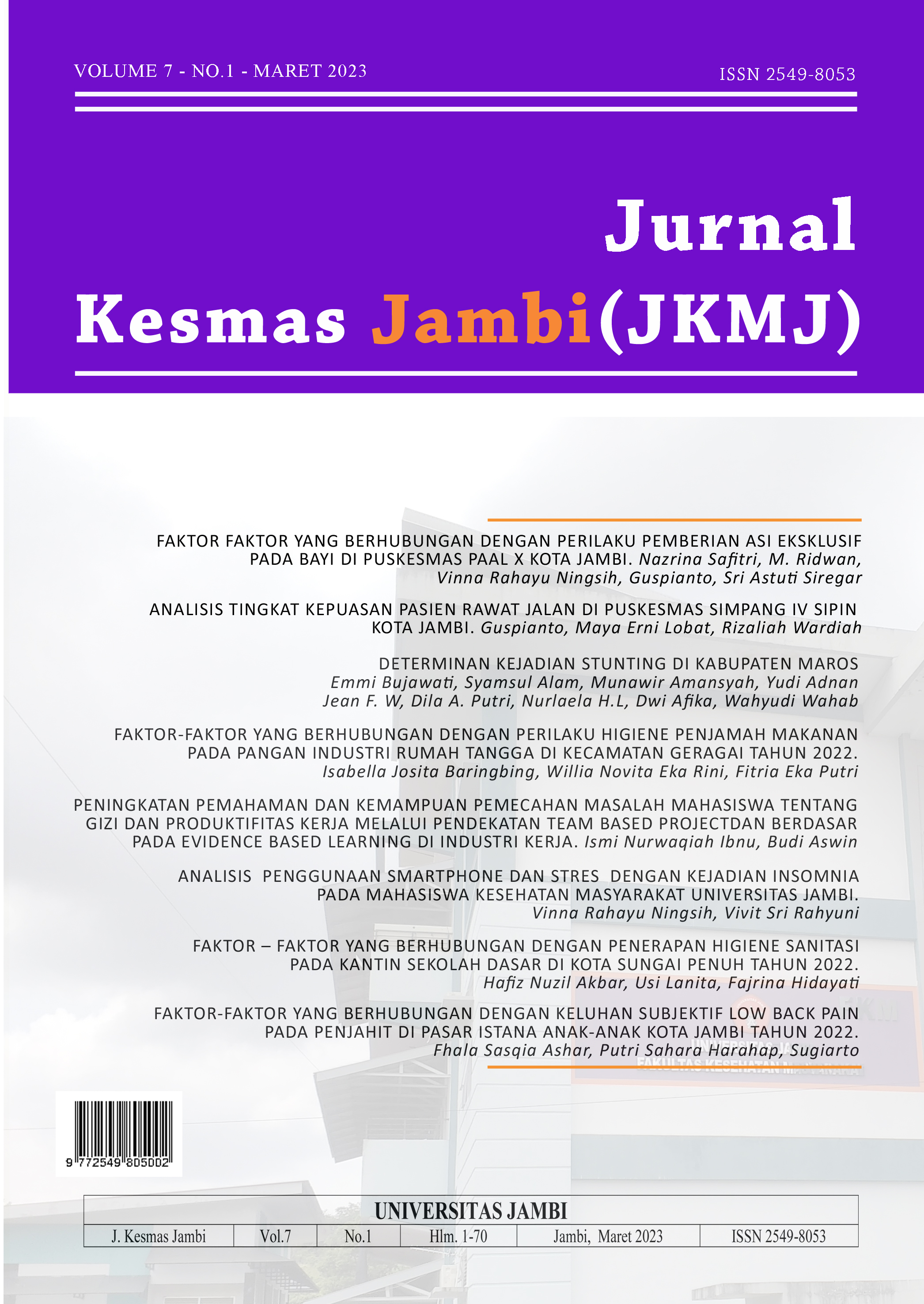Faktor-Faktor yang Berhubungan dengan Keluhan Subjektif Low Back Pain pada Penjahit di Pasar Istana Anak-Anak Kota Jambi Tahun 2022
DOI:
https://doi.org/10.22437/jkmj.v7i1.20445Abstract
Sewing is one of the risky jobs to experience low back pain (LBP) this is due to working with long sitting and non-ergonomic work positions. The Jambi City Children's Palace Market is the central tailor in Jambi City. The results of the observation showed that from 10 tailors, 7 experienced pain in the lower back when sewing. The purpose of the study was to determine the factors associated with complaints of LBP on tailors at the Children's Palace Market. The study used a cross sectional design. The research was conducted at the Istana Children's Market in Jambi City on 10-31 May 2022. The research population was all tailors at the Istana Anak Market. The research sample was 30 tailors at the Children's Palace Market in Jambi City. The research instrument was a questionnaire and RULA. Data collection techniques using interviews and observations of respondents' work attitudes. Data were analyzed using chi square test. As many as 53.3% of respondents have complaints of low back pain, 53.3% of respondents work with high-risk work attitudes, 60.0% of respondents work with risky work durations and 63.3% of respondents have long tenures. The results of the bivariate analysis showed that there was a relationship between work attitude (p=0.000) and tenure (p=0.011) with complaints of low back pain in tailors at the Children's Palace Market, Jambi City. There is no relationship between work duration (p-0.159) and complaints of low back pain in tailors at the Children's Palace Market, Jambi City.
Downloads
References
Andreani, M. U., & Paskarini, I. (2013). Sikap Kerja yang Berhubungan dengan Keluhan Subjektif Pada Penjahit di Jalan Patau Surabaya. Jurnal Promkes, 1(2), 201–208.
Arwinno, L. D. (2018). Keluhan Nyeri Punggung Bawah Pada Penjahit Garmen. Higeia Journal of Public Health Research and Development, 2(3), 406–416.
Awaluddin, et al. (2019). Hubungan Beban Kerja dan Sikap Kerja dengan Keluhan Low Back Pain Pada Pekerja Rumah Jahit Akhwat Makassar. JKMM, 2(1), 25–32.
Devira, et al. (2021). Hubungan Durasi Kerja dan Postur Kerja dengan Keluhan Low Back Pain (LBP) Penjahit Negari Kapuak Kabupaten Lima Puluh Kota. Jurnal Sehat Mandiri, 16(2), 138–146.
Icsal, M., Sabilu, Y., & Pratiwi, A. D. (2016). Faktor yang Berhubungan dengan Keluhan Muskulsokeletal Disorders Pada Penjahit Wilayah Pasar Panjang Kota Kendari Tahun 2016. Jurnal Kesehatan Masyarakat, 1(1), 1–8.
Irawati, N., Yogisutanti, G., & Sitorus, N. (2020). Hubungan Antara Status Gizi, Masa Kerja, dan Sikap Kerja dengan Gangguan Muskuloskeletal pada Penjahit di Jawa Barat. JPH RECODE, 4(1), 52–60.
PERDOSSI. (2016). Panduan Praktis Klinis Neurologi. Jakarta: PERDOSSI.
Prastuti, B., Sintia, I., Ningsih, & Warti, K. (2020). Hubungan Lama Kerja dan Posisi Duduk Terhadap Kejadian Low Back Pain Pada Penjahit di Kota Pekanbaru. Jurnal Endurance: Kajian Ilmiah Problema Kesehatan, 5(2).
Raya, R. I., Yunus, M., & Adi, S. (2019). Hubungan Intensitas Aktivitas Fisik dan Masa Kerja dengan Prevalensi dan Tingkat Low Back Pain Pada Pekerja Kuli Angkut Pasir. Sport Science Health, 1(2).
Samara. (2005). Duduk Statis sebagai Faktor Resiko Terjadinya Nyeri Punggung Bawah pada Pekerja Perempuan. Jurnal Universitas Medicina, 24(2), 77.
Tarwaka. (2014). Kesehatan Kerja: Manajemen dan Implementasi K3 di Tempat Kerja. Surakarta: Harapan Press.
Triana, D., Hengky, H. K., & Rusman, A. D. (2022). Pengaruh Lama Duduk Terhadap kejadian Nyeri Punggung Bawah Pada Tukang Jahit di Kota Pare-pare. Jurnal Ilmiah Manusia Dan Kesehatan, 5(2), 208–216.
WHO. (2013). Low Back Pain: Priority Medicines For Europe And The World. United States: WHO.
Widyasari, B. K., Affan, A., & Budiman, F. (2015). Hubungan Faktor Individu dan Faktor Risiko Ergonomi dengan Keluhan Low Back Pain (LBP) pada Penjahit Sektor Usaha Informal CV. Wahyu Langgeng Jakarta Tahun 2014. Jurnal Inohin, 2(2), 90–99.
Downloads
Published
Issue
Section
License
Copyright (c) 2023 Fhala Ashar, Putri Sahara Harahap, Sugiarto

This work is licensed under a Creative Commons Attribution 4.0 International License.
Proposed Creative Commons Copyright Notices
1. Proposed Policy for Journals That Offer Open Access
Authors who publish with this journal agree to the following terms:
- Authors retain copyright and grant the journal right of first publication with the work simultaneously licensed under a Creative Commons Attribution License that allows others to share the work with an acknowledgement of the work's authorship and initial publication in this journal.
- Authors are able to enter into separate, additional contractual arrangements for the non-exclusive distribution of the journal's published version of the work (e.g., post it to an institutional repository or publish it in a book), with an acknowledgement of its initial publication in this journal.
- Authors are permitted and encouraged to post their work online (e.g., in institutional repositories or on their website) prior to and during the submission process, as it can lead to productive exchanges, as well as earlier and greater citation of published work (See The Effect of Open Access).
Proposed Policy for Journals That Offer Delayed Open Access
Authors who publish with this journal agree to the following terms:
- Authors retain copyright and grant the journal right of first publication, with the work [SPECIFY PERIOD OF TIME] after publication simultaneously licensed under a Creative Commons Attribution License that allows others to share the work with an acknowledgement of the work's authorship and initial publication in this journal.
- Authors are able to enter into separate, additional contractual arrangements for the non-exclusive distribution of the journal's published version of the work (e.g., post it to an institutional repository or publish it in a book), with an acknowledgement of its initial publication in this journal.
- Authors are permitted and encouraged to post their work online (e.g., in institutional repositories or on their website) prior to and during the submission process, as it can lead to productive exchanges, as well as earlier and greater citation of published work (See The Effect of Open Access).



 p-ISSN :
p-ISSN :  e-ISSN :
e-ISSN : 


